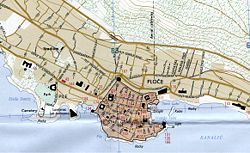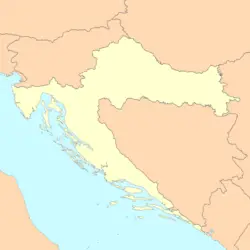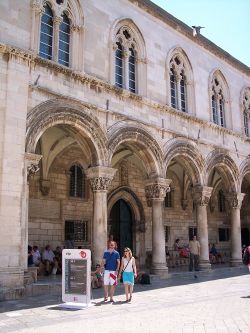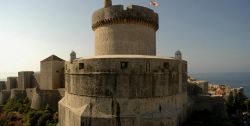Dubrovnik
| ||||||||||||||||||||||||||||||||||||||||||||
File:Old City, Dubrovnik.jpg Rooftops in Dubrovnik's Old City, a UNESCO World Heritage Site. | ||||||||||||||||||||||||||||||||||||||||||||
 Dubrovnik bridge of Franjo Tuđman and the Port of Gruž | ||||||||||||||||||||||||||||||||||||||||||||
- For the Yugoslav destroyer, see Dubrovnik (ship).
Dubrovnik (IPA: [ˈdǔ.bro̞ːʋ.niːk]; Dalmatian: Ragusa; Latin: Ragusium, also Rhausium, Rhaugia; Italian: Ragusa) is a city on the Adriatic Sea coast in the extreme south of Croatia. Regarded as the most picturesque city on the Dalmatian coast, it is one of the most prominent tourist destinations on the Adriatic, a seaport and the centre of Dubrovnik-Neretva county.
In 1979, the city of Dubrovnik joined the UNESCO list of World Heritage Sites.
The prosperity of the city of Dubrovnik has always been based on maritime trade. In the Middle Ages, as the Republic of Ragusa, it became the only eastern Adriatic city-state to rival Venice. Supported by its wealth and skilled diplomacy, the city achieved a remarkable level of development, particularly during the 15th and 16th centuries. Ragusa was one of the centres of the development of primarily the Croatian language and literature, home to many notable poets, playwrights, painters, mathematicians, physicists and other scholars.
Geography
The Slavic toponym Dubrovnik originates from the Proto-Slavic term for an oak forest *dǫbrava or *dǫbrova (dubrava in archaic and literary Croatian), which was abundantly present in the hills north of the walled city of Dubrovnik by the end of the 11th century. The current name was officially adopted in 1909, when the city was under Austro-Hungarian rule.
Positioned at the terminal end of the Isthmus of Dubrovnik, the city is located on a promontory jutting into the sea under the bare limestone Mount Srdj.
The Dubrovnik Region has a typical Mediterranean climate, with mild, rainy winters and hot and dry summers. However, the Bora wind blows uncomfortably cold gusts down the Adriatic coast between October and April, and thundery conditions are common all the year round. In July, daytime maximum temperatures reach 84°F (29°C), and in January drop to 54°F (12°C). Mean annual precipitation is 51 inches (1298mm).
Rivers and canals Size – land area, size comparison Environmental issues Districts
History
Government
Economy
Overview – Any specialization: For instance, is a manufactured product is associated with particular cities a. Milwaukee—cheese and beer b. Los Angeles—entertainment industry c. Sheffield—coal d. top 20 cities in the U.S. are highly specialized
Per capita GDP, rank Financial and business services sector Tourism Manufacturing Transport: Road, rail, air, sea
Demographics
Its population was 43,770 in 2001[1] down from 49,728 in 1991.[2]
In the 2001 census, 88.39% of its citizens declared themselves as Croats.
Language Religion Colleges and universities
Of interest
| Old City of Dubrovnik* | |
|---|---|
| UNESCO World Heritage Site | |
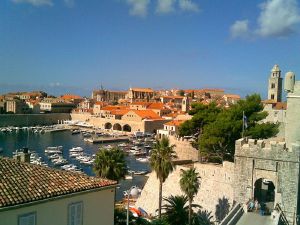
| |
| State Party | |
| Type | Cultural |
| Criteria | i, iii, iv |
| Reference | 95 |
| Region** | Europe and North America |
| Inscription history | |
| Inscription | 1979 (3rd Session) |
| Extensions | 1994 |
| Endangered | 1991-1998 |
| * Name as inscribed on World Heritage List. ** Region as classified by UNESCO. | |
The annual Dubrovnik Summer Festival is a cultural event when keys of the city are given to artists who entertain Dubrovnik's population and their guests for entire month with live plays, concerts, and games.
Ivan Gundulić, a 17th century Croatian writer, predicted the downfall of the great Turkish Empire in his great poem Osman. He wrote these immortal verses that are performed on every opening of the world famous Dubrovnik Summer Festival:
O, beautiful liberty, dear and sweet,
Thou heavenly gift where riches all meet,
Actual source of our glory of these hours,
The sole adornment of this grove of ours,
All silver, all gold, and our lives so dear,
Cannot recompense thy beauty so clear.
With these verses Dubrovnik major invites actors and poems to enter through main gates inside city stone walls. As a young actor Goran Višnjić played Hamlet at the Dubrovnik Summer Festival. He was noticed and approved by the public at the very start of his career. The Dubrovnik Summer Festival has been awarded its first Gold International Trophy for Quality (2007) by the Editorial Office in collaboration with the Trade Leaders Club.
February 3 is the feast of Sveti Vlaho (Saint Blaise), who is the city's patron saint. Every year the city of Dubrovnik celebrates the holiday with Mass, parades, and festivities that last for several days.[3]
Dubrovnik and its surroundings with numerous islands have a lot to offer in touristic activities for younger generations. Also popular are climbing on steep hills, hiking through the Mediterranean nature, and swimming in the clean, transparent sea.
New historical discoveries say that the usual misconception of Dubrovnik coming to be as joining of Laus island and Slav settlement of Dubrovnik is disputed by the fact that there was no island of Laus, only a peninsula, and it seems that there was a port on its location dating back to ancient history (thought to be the lost port of Heraclea).[citation needed]
The patron saint of the city is Sveti Vlaho (Saint Blaise), whose statues are seen around the city. He has an importance similar to that of St. Mark the Evangelist to Venice. The city's cathedral is named after Saint Blaise. The city boasts of many old buildings, such as the Arboretum Trsteno, the oldest arboretum in the world, dating back to before 1492. Also, the third oldest European pharmacy is located in the city, which dates back to 1317 (and is the only one still in operation today). It is located at Little Brothers church in Dubrovnik.[4]
In history, many Conversos (Marranos) were attracted to Dubrovnik, formerly a considerable seaport. In May, 1544, a ship landed there filled exclusively with Portuguese refugees, as Balthasar de Faria reported to King John. Another admirer of Dubrovnik, George Bernard Shaw, visited the city in 1929 and said: "If you want to see heaven on earth, come to Dubrovnik." This sentence is commonly used by tourist guides to describe the city.
In the bay of Dubrovnik is the 72-hectare wooded island of Lokrum, where according to legend, Richard the Lionheart was cast ashore after being shipwrecked in 1192. The island includes a fortress, botanical garden, monastery and naturist beach.
Dubrovnik has also been mentioned in popular film and theater. In the film 20,000 Leagues Under the Sea with Michael Caine, one of the characters said to have been dreaming of fairy from Dubrovnik (motive known from local legends and literature). In the film Rosemary's Baby, Roman Castevet, the leader of the witch coven, is falsely said to be in Dubrovnik, leading Rosemary to exclaim on his presence, "You're in Dubrovnik, I can't hear you." The 12th season of The Amazing Race, the remaining contestants went to the city of Dubrovnik.
Important monuments
Few of Dubrovnik's Renaissance buildings survived the earthquake of 1667 but fortunately enough remain to give an idea of the city's architectural heritage. [citation needed] The finest Renaissance highlight is the Sponza Palace which dates from the 16th century and is currently used to house the National Archives. The Rectors Palace is a Gothic-Renaissance structure that displays finely-carved capitals and an ornate staircase. It now houses a museum. The St Saviour Church is another fine remnant of the Renaissance period, next to the much-visited Franciscan Monastery. Over the entrance is a sculpture of the Pieta that dates from the late-Gothic period but the best part of the monastery is the Cloister with a colonnade of octagonal columns.
Dubrovnik's most beloved church is St Blaise's church, built in the 18th century in honor of Dubrovnik's patron saint. Dubrovnik's baroque Cathedral was built in the 18th century and houses an impressive Treasury with relics of Saint Blaise. The city's Dominican Monastery resembles a fortress on the outside but the interior contains an art museum and a Gothic-Romanesque church. [citation needed]
A striking feature of Dubrovnik is its walls that run 2km around the city. The walls run from four to six metres thick on the landward side but are much thinner on the seaward side. The system of turrets and towers were intended to protect the vulnerable city but now make one of the most picturesque sights in the Adriatic.[5]
Transport
Dubrovnik has an international airport of its own. The airport is located approximately 20 km (12 mi) from Dubrovnik city center, near Ćilipi. Buses connect the airport with the Dubrovnik bus station. In addition, a network of modern, local buses connects all Dubrovnik neighborhoods running frequently from dawn to midnight.
The A1 highway, in use between Zagreb and Šestanovac, is planned to be extended all the way to Dubrovnik. The highway will cross the, currently in construction, Pelješac Bridge. An alternative plan proposes the highway running from Neum through Bosnia and Herzegovina and an expressway continuing to Dubrovnik. This plan has fallen out of favor, though.
Education
Dubrovnik has a number of educational institutions. These include the University of Dubrovnik, a Nautical College, a Tourist College, a University Centre for Postgraduate Studies of the University of Zagreb, American College of Management and Technology, and an Institute of History of the Croatian Academy of Sciences and Arts.
Notable people from Dubrovnik
- Franco Sacchetti (1332-1400), Italian poet
- Marin Držić (1508-1567), Croatian playwright and prose writer
- Cvijeta Zuzorić (c. 1552 - c. 1600), Croatian poetess
- Dinko Zlatarić (1558-1613), Croatian poet and translator
- Marin Getaldić (1568–1626), Croatian scientist
- Ivan Gundulić (1589-1638) Croatian poet
- Ruđer Bošković (1711-1787), Croatian scientist, diplomat and poet
- Vlaho Getaldić (1788-1872), politician, noble, poet
- Niko Pucić (1820-1883) - Croatian politician and nobleman
- Medo Pucić (1821-1882) - Croatian writer, politician and nobleman
- Federico Seismit-Doda (1825-1893), Italian politician
- Frano Getaldić-Gundulić (1833-1899) - soldier, statesman, nobleman, Knight of Malta
- Pero Budmani (1835-1914), linguist
- Vlaho Bukovac (1855-1922),Croatian painter
- Ivo Vojnović (1857-1929), Croatian writer
- Antun Fabris (1864-1904), Croatian journalist and politician
- Frano Supilo (1870-1917), Croatian politician and journalist
- Blagoje Bersa (1873-1934),Croatian musician
- Eduard Miloslavić (1884-1952), scientist
- Branko Bauer (born 1921), Croatian film director
- Ottavio Missoni (born 1921), Italian fashion designer
- Marin Bunić (1924-1994), World War II survivor who led Croatian immigration wave to Lima, Peru
- Tereza Kesovija (born 1938), Croatian singer
- Božo Vuletić (born 1958), Croatian waterpolo player, Olympic gold medalist
- Goran Sukno (born 1959), Croatian waterpolo player, Olympic gold medalist
- Veselin Đuho (born 1960), Croatian waterpolo player and coach, double Olympic gold medalist
- Sanja Jovanović (born 1986), Olympic swimmer
Images
Panorama
Gallery
- Orlando, Dubrovnik, Croatia.JPG
The Orlando statue, symbol of a free city
- Dubrovnik walls.JPG
Dubrovnik as seen from its wall
See also
- Atlantska Plovidba d.d.
ReferencesISBN links support NWE through referral fees
- ↑ City of Dubrovnik. Dubrovnik.hr. Accessed on July 2, 2007
- ↑ Dubrovnik. History.com Encyclopedia. Accessed on July 2, 2007
- ↑ Dubrovnik news
- ↑ Dubrovnik Online, monuments in Dubrovnik
- ↑ Croatia Traveller, Dubrovnik
Further reading
- Harris, Robin. Dubrovnik, A History. London: Saqi Books, 2003. ISBN 0-86356-332-5
- Kremenjas-Danicic, Adriana (Editor-in-Chief): Roland's European Paths. Dubrovnik: Europski dom Dubrovnik, 2006. ISBN 953-95338-0-5
External links
- Encyclopaedia Britannica Dubrovnik Retrieved September 17, 2008.
- World Fact Book 2008 Croatia Retrieved September 17, 2008.
- Dubrovnik, Croatia BBC World Weather, retrieved September 17, 2008.
- Old City of Dubrovnik - UNESCO World Heritage Centre
- Dubrovnik picture gallery
- Dubrovnik Map - A Free Satellite image of Dubrovnik with pins on all important tourist locations.
Credits
New World Encyclopedia writers and editors rewrote and completed the Wikipedia article in accordance with New World Encyclopedia standards. This article abides by terms of the Creative Commons CC-by-sa 3.0 License (CC-by-sa), which may be used and disseminated with proper attribution. Credit is due under the terms of this license that can reference both the New World Encyclopedia contributors and the selfless volunteer contributors of the Wikimedia Foundation. To cite this article click here for a list of acceptable citing formats.The history of earlier contributions by wikipedians is accessible to researchers here:
The history of this article since it was imported to New World Encyclopedia:
Note: Some restrictions may apply to use of individual images which are separately licensed.

